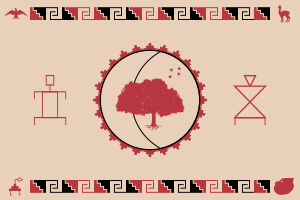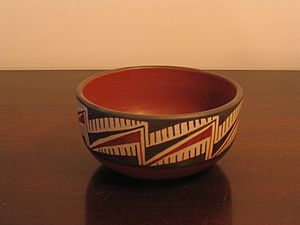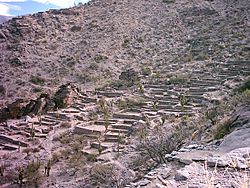Diaguita facts for kids
| Total population | |
|---|---|
| approximately 155,884 | |
| Regions with significant populations | |
| 88,474 | |
| 67,410 | |
| Languages | |
| Cacán (extinct) • Quechua • Spanish | |
| Related ethnic groups | |
| Atamaqueño • Quilmes | |
The Diaguita people are a group of South American indigenous people. They originally lived in the northern part of Chile and the northwest of Argentina. The Diaguitas in Chile lived mostly in valleys that cut through a dry, semi-desert area. The Diaguitas in Argentina lived in provinces like La Rioja and Catamarca. The name Diaguita was first used for these groups and their ancient cultures in the early 1900s.
Long ago, the Diaguitas were not one big group. They spoke different languages or dialects in different valleys. They were also divided into many small groups, each with its own leader. Diaguitas living near the coast and those living inland traded with each other. We know this because archaeologists have found seashells far up in the Andean valleys.
In 2010, about 67,410 people in Argentina said they were Diaguita descendants. In Chile, the Diaguitas are the third-largest indigenous group. In 2017, there were 88,474 Diaguitas there. The Chilean government officially recognized the Diaguitas as an indigenous people in 2006.
Diaguita Language
When the Spanish first arrived, they wrote that the Diaguitas in different valleys spoke different languages. Some experts think these might have been different versions, or dialects, of the same language. These dialects would have had different words.
A language called Cacán was thought to be the main language of the Diaguitas. Some scholars agree with this idea, while others question it.
It's interesting that there are not many place names (toponyms) in the northern part of Chile that come from the Diaguita language. Most of the old place names there are from the Quechua or Mapuche languages.
Diaguita History
The Diaguita culture began with an older group called the El Molle complex. This group lived from about 300 to 700 CE (Common Era). Later, a new culture called the Las Ánimas complex took its place in Chile, from 800 to 1000 CE. The Diaguita culture as we know it grew from this Las Ánimas culture around 1000 CE. During the main Diaguita period, they had advanced ways to water their crops. They also made beautiful pottery painted in black, white, and red.
Some Mapuche communities lived in the southern Diaguita lands. These areas include Petorca, La Ligua, and Choapa. These Mapuche communities might have been there for hundreds of years before the Spanish arrived. Many place names in these areas are also Mapuche. While some Mapuches moved to these lands later, their culture there seems to be very old.
Some people believe the Inca Empire took over Diaguita lands because of their valuable minerals. However, this idea is still being discussed. Another idea is that the Incas wanted to control the Diaguita valleys to get workers for their mines in Chile. Most experts agree that the Incas conquered the Diaguitas through fighting. This caused many people to leave the valleys in northern Chile. The Diaguitas, especially the Calchaquí Diaguitas, were not easy for the Inca Empire to conquer.
Once conquered, not all eastern Diaguitas accepted Inca rule. The Incas put their own leaders in charge and moved some people to new areas in Chilean Diaguita lands. The Diaguitas learned from the Incas. They started using pottery designs from Cuzco and adopted Inca farming and metalworking methods.
The Chilean Diaguitas were conquered by Spanish explorers coming from Peru. Spanish explorers from Chile, the Paraná River, and Peru explored the eastern Diaguita lands. In what became known as the Calchaquí Wars, the Spanish struggled to conquer the fertile valleys where the Eastern Diaguitas lived. They could only control the edges of these valleys.
To gain more control, the Spanish built cities like Santiago del Estero (in the 1550s), Tucumán (1565), Salta (1582), La Rioja (1591), and Jujuy (1593). These cities formed a barrier around the rebellious Eastern Diaguita valleys. The city of Londres was founded in 1607 right in the middle of the Eastern Diaguita territory to help control them.
Between 1557 and 1561, during the time of García Hurtado de Mendoza in Chile, many Chilean Diaguitas who rebelled were defeated by the Spanish. The Calchaquí Diaguitas in the eastern Andes fought against Spanish rule in 1630. The last rebels continued fighting until 1642–1643. During this rebellion, the Spanish city of La Rioja was almost destroyed. The Calchaquí Diaguitas finally came under Spanish rule after 1665.
Over time, the Diaguita languages in Chile may have been mostly lost. This happened as Diaguita people mixed with Mapuche-speaking groups.
Archaeological Timeline in Chile
This table shows the different periods and cultures of the Diaguita people in Chile.
| Period | Culture | Pottery Style |
| Late (1000 CE–1550 CE) |
Hispanic | Diaguita, Inca and Colonial |
| Diaguita culture | Diaguita III and Inca | |
| Diaguita II | ||
| Diaguita I | ||
| Middle (700 CE–1000 CE) |
Las Ánimas culture | Las Ánimas ceramics (I, II and III) |
| Early (300 BCE–700 CE) |
El Molle culture | El Molle ceramics |
See also
 In Spanish: Diaguitas para niños
In Spanish: Diaguitas para niños




